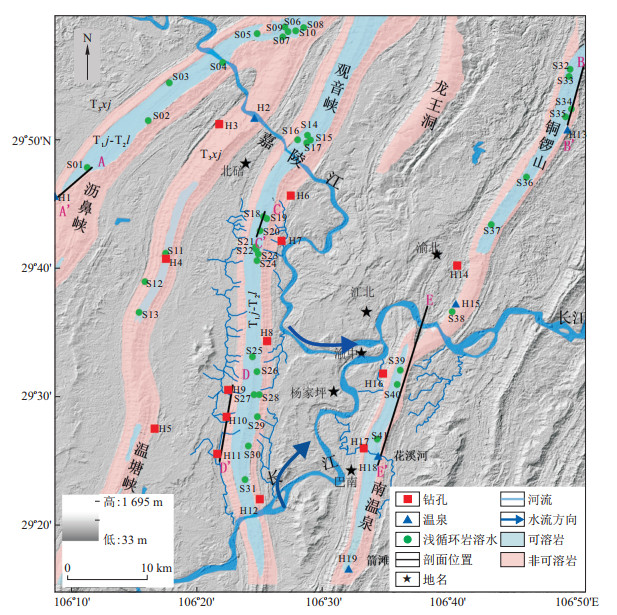Hydrogeochemical indicators of hierarchically nested structure of karst groundwater flow systems in the ejective folds area
-
摘要:
川东隔档式构造区岩溶地下水流系统表现出多级次嵌套结构的特征, 之前主要是定性的水文地质条件分析, 缺乏来自水化学方面的量化依据。利用41个浅层和19个深层岩溶水样的水化学资料开展分析, 发现浅层岩溶水为HCO3-Ca·Mg型,
ρ (Mg2+)较低, 深层岩溶水为SO4-Ca·Mg型且ρ (Mg2+)明显偏高, 说明地下水在岩溶含水层中的滞留时间与ρ (Mg2+)具有正变关系。对典型剖面地下水流系统的分析表明, 优先采用ρ (Mg2+)来评价地下水滞留时间, 将地下水排泄点ρ (Mg2+)小于20, 50 mg/L分别作为划分局部-中间、中间-区域水流系统的依据。浅层岩溶水受地貌作用控制明显, 其中浅切沟谷泉点为局部地下水流系统的排泄点, 深切沟谷泉点一般属于中间或区域流动系统的排泄点。ρ (Mg2+)反映了泉水循环的滞留时间, 也能够反映钻孔所揭露的深循环特征。这种水化学识别方法可为相似岩溶区识别地下水流系统的多级次嵌套结构提供参考。Abstract:The karst groundwater flow system in the ejective folds area in the eastern Sichuan Basin shows the characteristics of a hierarchically nested structure. However, previous studies were mainly focused on hydrogeological conditions analysis, lacking qualitative evidence directly from hydrochemistry. In this study, the authors collected and sorted the chemistry data of representative karst springs and boreholes in the study area, namely, 41 shallow karst waters and 19 deep ones. The Pipper chart shows that the shallow karst water is HCO3-Ca·Mg and low Mg2+ concentration, while the deep karst water is SO4-Ca·Mg and high Mg2+ concentration. For both shallow and deep karst groundwater, the analysis of the groundwater flow system of a typical profile shows that the Mg2+ concentration value can be used to evaluate the groundwater residence time. The shallow karst groundwater system is highly controlled by geomorphology, among which the shallow incised valley springs are the discharge points of the local groundwater flow system. However, springs in deep gullies correspond to intermediate or even regional flow systems. This pattern is verified by the groundwater residence time evaluation from the Mg2+ concentration, which also reflects the movement characteristics of deep-circulation groundwater flow revealed by hot springs and boreholes.The hydrochemical characteristics can effectively indicate the pattern of groundwater flow systems. This paper provides a reference for identifying the hierarchically nested structure of groundwater flow systems in similar karst areas.
-
-
[1] Xiao Q, Jiang Y, Shen L, et al. Origin of calcium sulfate-type water in the Triassic carbonate thermal water system in Chongqing, China: A chemical and isotopic reconnaissance[J]. Applied Geochemistry, 2018, 89: 49-58. doi: 10.1016/j.apgeochem.2017.11.011 [2] 肖琼. 重庆三叠系碳酸盐岩热储成因与水-岩作用过程研究[D]. 重庆: 西南大学, 2012.Xiao Q. Research on the genesis and water-rock interaction process of Triassic carbonate rock in Chongqing[D]. Chongqing: Southwest University, 2012 (in Chinese with English abstract). [3] Yang P H, Cheng Q, Xie S, et al. Hydrogeochemistry and geothermometry of deep thermal water in the carbonate formation in the main urban area of Chongqing, China[J]. Journal of Hydrology, 2017, 549: 50-61. doi: 10.1016/j.jhydrol.2017.03.054 [4] 肖琼, 沈立成, 袁道先, 等. 利用δ18O和δ34S示踪重庆都市圈地下热水循环过程[J]. 重庆大学学报, 2011, 34(5): 87-92. https://www.cnki.com.cn/Article/CJFDTOTAL-FIVE201105016.htmXiao Q, Sheng L C, Yuan D X. Analysis on the source and replenishment mechanism of underground hot water: Taking Chongqing Beiwenquan as an example[J]. Journal of Chongqing University, 2015, 38(4): 91-103 (in Chinese with English abstract). https://www.cnki.com.cn/Article/CJFDTOTAL-FIVE201105016.htm [5] 杨平恒. 重庆青木关地下河系统的水文地球化学特征及悬浮颗粒物运移规律[D]. 重庆: 西南大学, 2010.Yang P H. The hydrogeochemical characteristics and the movement of suspended particles in the Qingmuguan underground river system in Chongqing[D]. Chongqing: Southwest University, 2010 (in Chinese with English abstract). [6] Tóth J. A theoretical analysis of groundwater flow in small drainage basins[J]. Journal of Geophysical Research, 1963, 68(16): 4795-4812. doi: 10.1029/JZ068i016p04795 [7] 梁杏, 张人权, 牛宏, 等. 地下水流系统理论与研究方法的发展[J]. 地质科技情报, 2012, 31(5): 143-151. https://www.cnki.com.cn/Article/CJFDTOTAL-DZKQ201205020.htmLiang X, Zhang R Q, Niu H, et al. Development of groundwater flow system theory and research methods[J]. Geological Science and Technology Information, 2012, 31(5): 143-151(in Chinese with English abstract). https://www.cnki.com.cn/Article/CJFDTOTAL-DZKQ201205020.htm [8] Li J, Liu J, Pang Z, et al. Characteristics of chemistry and stable isotopes in groundwater of the Chaobai River catchment, Beijing[J]. Procedia Earth and Planetary Science, 2013, 7: 487-490. doi: 10.1016/j.proeps.2013.03.092 [9] Adomako D, Osae S, Akiti T T, et al. Geochemical and isotopic studies of groundwater conditions in the Densu River Basin of Ghana[J]. Environmental Earth Sciences, 2011, 62(5): 1071-1084. doi: 10.1007/s12665-010-0595-2 [10] Mechal A, Birk S, Dietzel M, et al. Groundwater flow dynamics in the complex aquifer system of Gidabo River Basin (Ethiopian Rift): A multi-proxy approach[J]. Hydrogeology Journal, 2017, 25(2): 519-538. doi: 10.1007/s10040-016-1489-5 [11] Edmunds W M, Ma J, Aeschbach-Hertig W, et al. Groundwater recharge history and hydrogeochemical evolution in the Minqin Basin, North West China[J]. Applied Geochemistry, 2006, 21(12): 2148-2170. doi: 10.1016/j.apgeochem.2006.07.016 [12] Han D, Liang X, Jin M, et al. Hydrogeochemical indicators of groundwater flow systems in the Yangwu River alluvial fan, Xinzhou Basin, Shanxi, China[J]. Environmental Management, 2009, 44(2): 243-255. doi: 10.1007/s00267-009-9301-0 [13] Zhang J, Liang X, Jin M, et al. Identifying the groundwater flow systems in a condensed river-network interfluve between the Han River and Yangtze River (China) using hydrogeochemical indicators[J]. Hydrogeology Journal, 2019, 27(7): 2415-2430. doi: 10.1007/s10040-019-01994-1 [14] Jianjun W, Xing L, Bin M, et al. Using isotopes and hydrogeochemistry to characterize groundwater flow systems within intensively pumped aquifers in an arid inland basin, Northwest China[J]. Journal of Hydrology, 2021, 595: 126048. doi: 10.1016/j.jhydrol.2021.126048 [15] 梁杏, 张婧玮, 蓝坤, 等. 江汉平原地下水化学特征及水流系统分析[J]. 地质科技通报, 2020, 39(1): 21-33. doi: 10.19509/j.cnki.dzkq.2020.0103Liang X, Zhang J W, Lan K, et al. Groundwater chemical characteristics and flow system analysis in Jianghan Plain[J]. Bulletin of Geological Science and Technology, 2020, 39(1): 21-33 (in Chinese with English abstract). doi: 10.19509/j.cnki.dzkq.2020.0103 [16] 张晓旭, 周爱国, 刘运德, 等. 鄂尔多斯盆地多级次地下水流系统中硝酸盐分布特征及其成因[J]. 地质科技通报, 2022, 41(1): 231-239. doi: 10.19509/j.cnki.dzkq.2022.0022Zhang X X, Zhou A G, Liu Y D, et al. Characteristics and genesis of nitrate distribution in a multi-level groundwater flow system in the Ordos Basin[J]. Bulletin of Geological Science and Technology, 2022, 41(1): 231-239 (in Chinese with English abstract). doi: 10.19509/j.cnki.dzkq.2022.0022 [17] 邹成杰, 何宇彬. 喀斯特地貌发育的时空演化问题初论[J]. 中国岩溶, 1995(1): 49-59. https://www.cnki.com.cn/Article/CJFDTOTAL-ZGYR501.006.htmZhou C J, He Y B. A preliminary discussion on the temporal and spatial evolution of karst landform development[J]. Carsologica Sinica, 1995(1): 49-59 (in Chinese with English abstract). https://www.cnki.com.cn/Article/CJFDTOTAL-ZGYR501.006.htm [18] 罗鉴银, 傅瓦利. 岩溶地区开凿隧道对地下水循环系统的破坏: 以重庆市中梁山为例[J]. 西南农业大学学报: 自然科学版, 2005, 27(4): 432-435. doi: 10.3969/j.issn.1673-9868.2005.04.002Luo J Y, Fu W L. The destruction of groundwater circulation system caused by tunnel excavation in karst area: Taking Zhongliang Mountain in Chongqing as an example[J]. Journal of Southwest Agricultural University: Natural Science Edition, 2005, 27(4): 432-435 (in Chinese with English abstract). doi: 10.3969/j.issn.1673-9868.2005.04.002 [19] 钟玲敏, 许模, 吴明亮, 等. 多级水流系统耦合下深部岩溶分异研究: 以川东隔挡式构造区中梁山背斜南段为例[J]. 水文地质工程地质, 2018, 45(1): 45-51. https://www.cnki.com.cn/Article/CJFDTOTAL-SWDG201801007.htmZhong L M, Xu M, Wu M L, et al. Study on the differentiation of deep karst under the coupling of multi-stage water flow system: Taking the southern section of Zhongliangshan anticline in east Sichuan barrier structure area as an example[J]. Hydrogeology & Engineering Geology, 2018, 45(1): 45-51 (in Chinese with English abstract). https://www.cnki.com.cn/Article/CJFDTOTAL-SWDG201801007.htm [20] 拓明明. 四川盆地东部重庆主城区附近盆地-背斜出露型地下热水特征及成因机制[D]. 北京: 中国地质大学(北京), 2020.Tuo M M. Characteristics and genetic mechanism of basin-anticline outcropping geothermal water near the main urban area of Chongqing in the eastern part of the Sichuan Basin[D]. Beijing: China University of Geosciences (Beijing), 2020 (in Chinese with English abstract). [21] 漆继红, 许模, 杨华云, 等. 川东铜锣山背斜-南温泉背斜温泉水力联系分析[J]. 人民长江, 2011, 42(11): 5-9. https://www.cnki.com.cn/Article/CJFDTOTAL-RIVE201111003.htmQi J H, Xu M, Yang H Y, et al. Analysis of hot spring hydraulic connection between Tongluoshan anticline and South Hot Spring anticline in eastern Sichuan[J]. People's Yangtze River, 2011, 42(11): 5-9 (in Chinese with English abstract). https://www.cnki.com.cn/Article/CJFDTOTAL-RIVE201111003.htm [22] 苏丕辉. 重庆东泉隧道对统景温泉地下水环境影响研究[D]. 成都: 西南交通大学, 2020.Su P H. Research on the impact of Chongqing Dongquan Tunnel on the groundwater environment of Tongjing Hot Spring[D]. Chengdu: Southwest Jiaotong University, 2020(in Chinese with English abstract). [23] 张瑞. 岩溶槽谷区既有隧道条件下新建隧道渗流特征及涌水量预测[D]. 重庆: 重庆大学, 2017.Zhang R. Seepage characteristics and water inflow prediction of new tunnels under the condition of existing tunnels in karst troughs and valleys[D]. Chongqing: Chongqing University, 2017 (in Chinese with English abstract). [24] Ta M M, Zhou X, Xu Y Q, et al. Occurrence and flow systems of the anticline-controlled thermal groundwater near Chongqing in eastern Sichuan Basin of China[J]. Hydrogeology Journal, 2020, 51(4): 739-749. [25] Jiang X W, Wan L, Cardenas M B, et al. Simultaneous rejuvenation and aging of groundwater in basins due to depth-decaying hydraulic conductivity and porosity[J]. Geophysical Research Letters, 2010, 37(5): L05403. [26] 牛宏, 魏小雅, 林晶晶, 等. 盆地多级次地下水流系统盐分运移实验模拟[J]. 地质科技通报, 2022, 41(1): 177-182. doi: 10.19509/j.cnki.dzkq.2022.0019Niu H, Wei X Y, Lin J J, et al. Experimental simulation of salt transport in a multi-level groundwater flow system in the basin[J]. Bulletin of Geological Science and Technology, 2022, 41(1): 177-182 (in Chinese with English abstract). doi: 10.19509/j.cnki.dzkq.2022.0019 [27] Jiang X W, Wan L, Ge S, et al. A quantitative study on accumulation of age mass around stagnation points in nested flow systems[J]. Water Resources Research, 2012, 48(12): W12502. [28] 蒋小伟, 万力, 王旭升, 等. 盆地地下水年龄空间分布规律[J]. 水文地质工程地质, 2012, 39(4): 1-6. https://www.cnki.com.cn/Article/CJFDTOTAL-SWDG201204003.htmJiang X W, Wang L, Wang X S, et al. Spatial distribution of groundwater age in the basin[J]. Hydrogeology & Engineering Geology, 2012, 39(4): 1-6(in Chinese with English abstract). https://www.cnki.com.cn/Article/CJFDTOTAL-SWDG201204003.htm [29] Tóth J. Groundwater as a geologic agent: An overview of the causes, processes, and manifestations[J]. Hydrogeology Journal, 1999, 7(1): 1-14. [30] Plummer L N. Defining reactions and mass transfer in part of the Floridan aquifer[J]. Water Resources Research, 1977, 13(5): 801-812. [31] Donald L. The geochemistry of some carbonate ground waters in central Pennsylvania[J]. Pergamon, 1971, 35(10): 1023-1045. [32] Wigley T M L. The incongruent solution of dolomite[J]. Pergamon, 1973, 37(5): 1397-1402. [33] Batiot C, Emblanch C, Blavoux B. Carbone organique total (COT) et magnésium (Mg2+): Deux traceurs complémentaires du temps de séjour dans l'aquifère karstique[J]. Comptes Rendus-Géoscience, 2003, 335(2): 205-214. [34] Celle-Jeanton H, Emblanch C, Mudry J, et al. Contribution of time tracers (Mg2+, TOC, δ13CDIC, NO3-) to understand the role of the unsaturated zone: A case study-Karst aquifers in the Doubs valley, eastern France[J]. Geophysical Research Letters, 2003, 30(6): 1322. [35] Luo M, Chen Z, Criss R E, et al. Dynamics and anthropogenic impacts of multiple karst flow systems in a mountainous area of South China[J]. Hydrogeology Journal, 2016, 24(8): 1993-2002. [36] Huang H, Chen Z, Wang T, et al. Nitrate distribution and dynamics as indicators to characterize karst groundwater flow in a mined mineral deposit in southwestern China[J]. Hydrogeology Journal, 2019, 27(6): 2077-2089. [37] Yoshimoto S, Ishida S, Kobayashi T, et al. Using hydrogeochemical indicators to interpret groundwater flow and geochemical evolution of a freshwater lens on Majuro Atoll, Republic of the Marshall Islands[J]. Hydrogeology Journal, 2020, 28(3): 1053-1075. [38] Lalbat F, Blavoux B, Banton O. Description of a simple hydrochemical indicator to estimate groundwater residence time in carbonate aquifers[J]. Geophysical Research Letters, 2007, 34(19): L19403. [39] 蒋小伟, 万力, 王旭升. 区域地下水流理论进展[M]. 北京: 地质出版社, 2013.Jiang X W, Wan L, Wang X S. The progress of regional groundwater flow theory[M]. Beijing: Geological Press, 2013(in Chinese). -





 下载:
下载:












